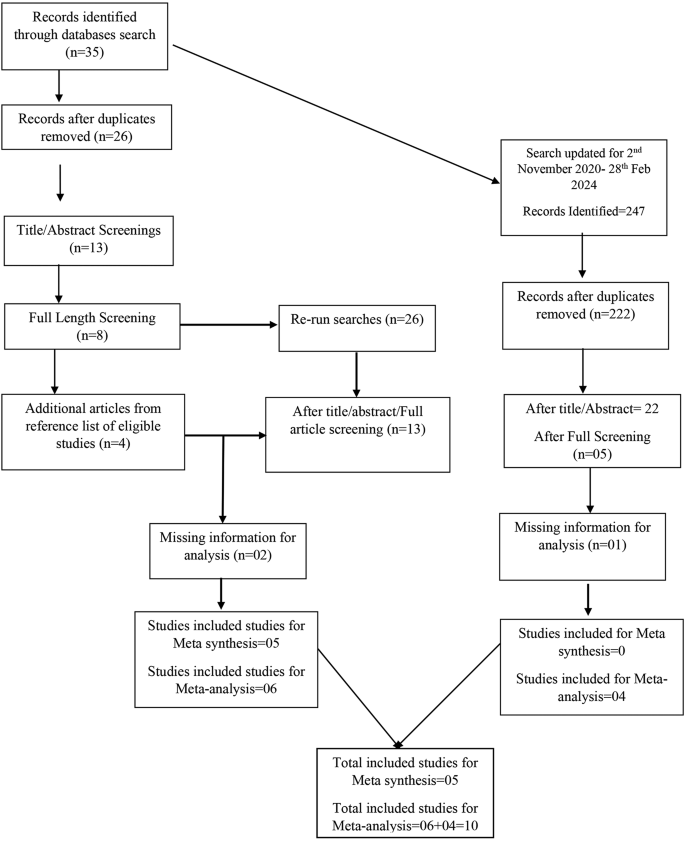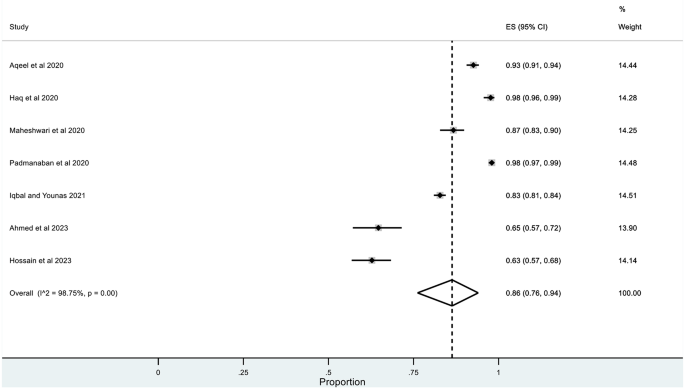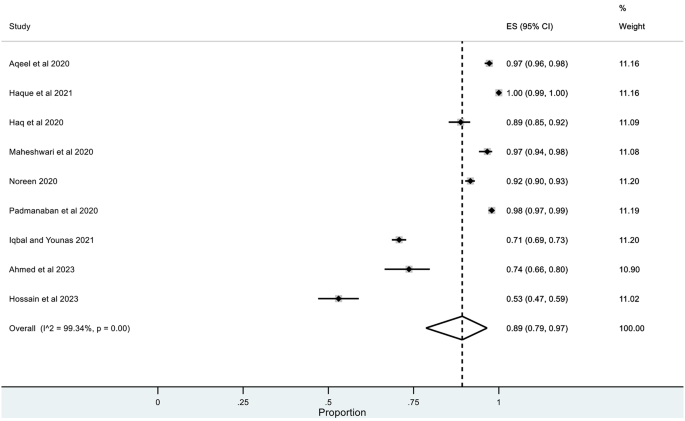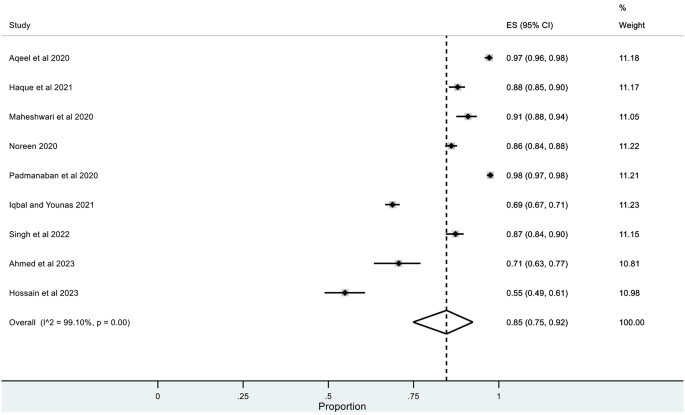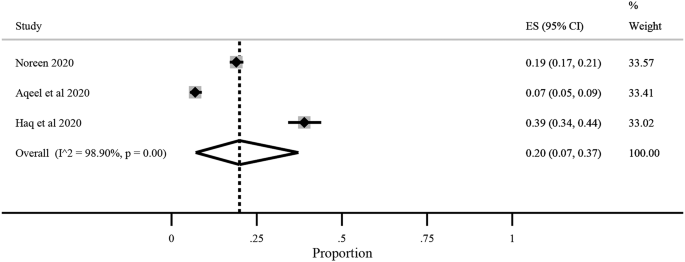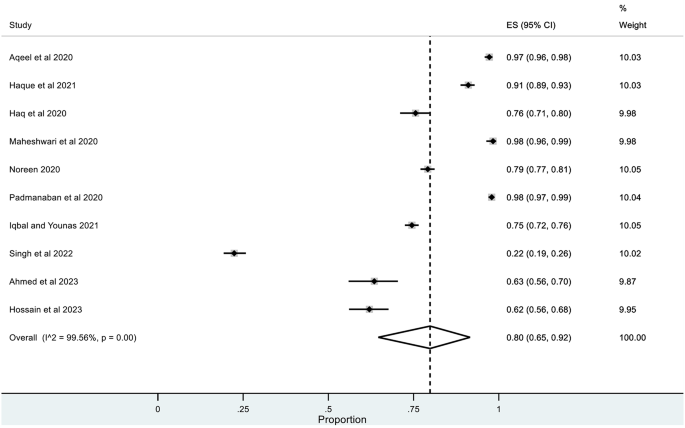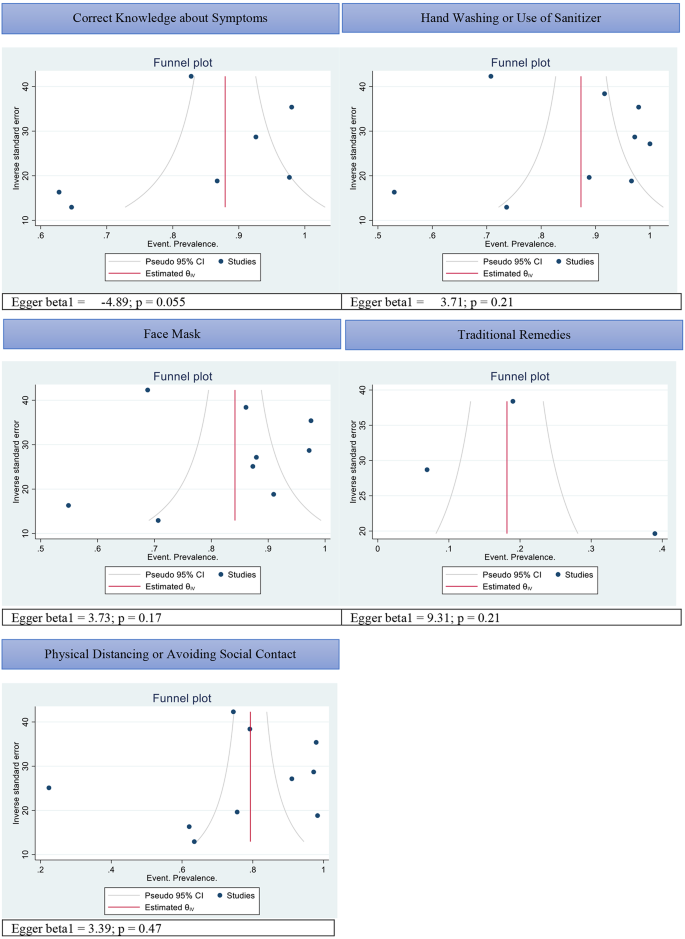- Research
- Open access
- Published:
An examination of the relationship between risk perceptions, cultural-religious beliefs and coping during COVID-19 pandemic control in South Asian countries: a systematic review
BMC Psychology volume 12, Article number: 461 (2024)
Abstract
Background
Covid 19 was declared as a public health emergency by the World Health Organisation (WHO) due to its rapid spread and catastrophic effects on health. It affected around 119 M people with mortality rate of 0.27% worldwide, including South-Asians. This review aims to understand the risk perceptions, cultural religious beliefs and the coping mechanisms of South Asians during the Covid 19 pandemic.
Methods
We conducted a systematic review following the Preferred Reporting Items for Systematic Reviews and Meta-Analyses (PRISMA) guidelines. The following search engines were used: Medline, Cochrane Library, PsycINFO, CINAHL, and Web of Science. Included studies investigated perceptions and opinions of individuals on knowledge, risk and protective factors, native faith based practices, and attitudes towards the COVID-19 pandemic.
Results
The database search produced 282 articles to screen. The final narrative synthesis included five studies comprising of 13,476 participants from Pakistan, India, Nepal, and Bangladesh. Ten studies, comprising 7,893 participants, were eligible and included for meta-analysis. The overall pooled prevalence with maximum heterogeneity for correct knowledge of symptoms, hand washing or use of sanitizers, face masking use of herbal or traditional remedies and physical distancing or avoidance of contact was reported through meta-analysis.
Conclusion
The review brings forth a useful comparison of individual and cultural differences in KAP, risk perceptions and coping strategies. This review highlights the need for and importance of tailored information dissemination, culturally sensitive risk communication, targeted educational interventions, community engagement and empowerment, policy, and infrastructure improvements, as well as continued research and data collection. By addressing these implications, efforts to mitigate the impact of COVID-19 can be more effective and equitable across diverse populations.
Prospero registration
CRD42021246475.
Introduction
A novel coronavirus SARS-Cov-2 was first identified as a causal pathogen of COVID-19 disease in humans in December 2019 in Wuhan, China [1]. COVID-19 spread rapidly around the globe and was declared a pandemic by the World Health Organisation (WHO) on March 11, 2020. Since it was first identified, SARS-CoV-2 has infected more than 119 M individuals around the globe (WHO, 2020) with a mortality rate of 0.27% [2]. South Asian countries account for 10% of COVID-19 cases around the globe [2] with a Case Fatality Rate (CFR) of 3.5% which is far less than that of economically developed countries (8.0%) [3, 4] owing to the differences in the structure of age group [5]. Statistical trends indicate that, among South Asian countries, India has the highest number of reported COVID-19 cases and deaths whilst Bhutan has the lowest [6].
Containment of COVID-19 is heavily dependent on the precautionary measures taken by the masses [7] which are, in turn, dependent on risk perception [8] and health beliefs [9]. Risk perception is a subjective judgement or belief of an individual regarding the severity of potential harm and an important driving factor of protective behavior [10, 11]. In addition to risk perception, health beliefs also play an important role in determining attitudes and behaviour towards the pandemic [12]. As per the Health Belief model, perceived benefits, perceived susceptibility, perceived severity, perceived barriers, and cue-to‐action influence such attitudes and behaviour [13].
In addition to risk perception and health beliefs, the ‘Knowledge, Attitude, and Practice’ (KAP) framework has also been used to identify how knowledge about diseases can affect attitude, practice, and disease burden associated with it [14,15,16]. In the context of COVID-19, KAP refers to understanding people’s correct knowledge about the virus, their attitudes towards it, and their native faith based practices they adopt to prevent its spread. Knowledge about COVID-19 is relatively high among the general population and they hold a positive attitude towards protective measures such as wearing a mask, washing hands, and using hand sanitizer etc. [17,18,19]. However, the most common source of knowledge about COVID-19 is social media [20, 21]. The KAP has been noted as above average among individuals with higher education, females, and healthcare professionals [22]. Similarly, females are more inclined towards taking precautionary measures than males [19, 20].
High-risk perception and perceived severity of COVID-19 can have a direct impact on the mental health of the individual [23,24,25]. Commonly experienced mental disorders during the COVID-19 pandemic in South Asian countries include nonpsychotic depression, anxiety, insomnia, alcohol-related disorder, and somatic concerns [23, 25]. however, due to the strict adherence of most South Asian countries to religion, most inhabitants of these countries tend to turn towards religion and use religious coping mechanisms to deal with major life stressors [26]. Religiously framed behavioral, emotional, or cognitive responses to stressors are known as religious coping [27]. In other words, religious coping refers to help-seeking from religion – holy scriptures and therapy from religious leaders – in a stressful situation to reduce distressing thoughts and emotions [28]. Religious coping during COVID-19 has shown evidence to lower depressive symptoms [29] and stress [30], lesser loneliness [31] improve positive affect and life satisfaction [32]. Though literature examining risk perceptions, cultural-religious beliefs and coping during the covid-19 pandemic from many countries is available, a combined glance especially through the lens of a multicultural and multi-religious group like South Asia remains understudied to date. For example, a review of pandemic perceptions [33] found that different religious traditions hold differing beliefs (it’s a religious curse or only religion can save us) regarding infectious diseases. Therefore, the current systematic review aims to find out the KAP of South Asians toward COVID-19 and their coping mechanism for dealing with COVID-19, Which focuses on.
-
1.
Knowledge: This refers to what South Asians know about COVID-19. It could include their correct understanding of the virus, its transmission, symptoms, preventive measures, available treatments, and vaccination.
-
2.
Attitudes: This encompasses the beliefs, opinions, and perceptions that South Asians hold about COVID-19. It could include their level of concern, fear, trust in authorities or healthcare systems, perception of risk, and attitudes towards preventive measures such as mask-wearing, social distancing, and vaccination.
-
3.
Practices: This refers to the actions and behaviors that South Asians adopt in response to COVID-19. It could include their adherence to preventive measures, such as wearing masks, practicing hand hygiene, maintaining social distance, avoiding large gatherings, and seeking healthcare when necessary.
Moreover, the systematic review aims to explore the native faith based practices employed by South Asians to deal with the challenges posed by COVID-19. Coping mechanisms are the strategies individuals use to manage stress, anxiety, and other negative emotions associated with the pandemic. These mechanisms could include seeking social support, engaging in positive activities, practicing mindfulness or relaxation techniques, maintaining routines, and accessing mental health services.
Method
Protocol registration
A systematic review protocol was developed and registered online with PROSPERO (CRD42021246475). This review followed the Preferred Reporting Items for Systematic Reviews and Meta-Analyses (PRISMA) reporting guidelines [34].
Databases and search strategy
The following electronic databases (Inception to 1st November 2020): Medline, Cochrane Library, PsycINFO, CINAHL, and Web of Science, were searched using four concepts including knowledge and practices, culture, COVID-19, and South Asia. The overall search strings were: (Perception OR Knowledge OR Information OR Attitude* OR Awareness OR Practices OR Opinions OR Beliefs) AND (Religiou*) AND (COVID-19 OR COVID OR Coronavirus OR SARS-CoV-2) AND (Pakistan OR India OR Bangladesh OR Sri Lanka OR Nepal OR Bhutan OR Maldives OR Afghanistan OR South Asia*) (See Table 1). A search update was run from 2nd November 2020 to 28th Feb 2024 in get all other potential eligible articles.
Eligibility criteria and selection of studies
This review looked for studies with any quantitative data including but not limited to cross-sectional, cohort studies, case-control studies, interrupted time series or mixed methods research. No restrictions were placed on participants’ characteristics about age, morbidity, or socio-economic status. Included studies investigating perceptions and opinions of individuals on knowledge, risk and protective factors, practices, cultural traditions, and attitudes towards the COVID-19 pandemic. Studies reporting findings only from South Asian countries in the English language were considered for inclusion. Title/ abstract and full-text screening were performed by two reviewers independently (AK, VR). Any discrepancies were resolved through discussion with third reviewer arbitration (RM).
The following PECO* framework explains the eligibility criteria more precisely.
P | South Asian Countries |
E | General Population exposed to covid-19 pandemic, however, it doesn’t refer that such a population is diagnosed with Covid-19 |
C | Not Applicable |
O | Knowledge, Attitude and Practices regarding Covid-19 (KAP) |
Data extraction
Extracted data included study details (author, date, study location), study design information (type of design, recruitment method), participant characteristics (target sample, age, gender), measures used, and results of analyses. Studies reporting knowledge or practices in mean or median were not included in quantitative synthesis. Two independent reviewers (AK, MA) carried out the data extraction for each study, and then compared, with discrepancies resolved through discussion.
Risk of bias assessment
The quality of the included studies was evaluated using a Risk of Bias (ROB) assessment of Joanna Briggs Institute (JBI) for prevalence data studies tool. This tool assesses ROB over nine domains, including participant recruitment, sample size and calculation, study subjects, measurement tools and appropriateness of analysis methods (see Table 2). Ratings were made independently by two reviewers (MA, VR) and any conflicts were resolved through third reviewer arbitration (AK). Funnel plots along with egger test value was reported for potential publication bias. Updated searches were screened and extracted by two independent researchers (BA, AK).
Data synthesis
Narrative synthesis and meta-analysis were utilized for data synthesis. We decided to perform a meta-analysis if at least 3 studies were provided with homogenous characteristics allowing meaningful interpretation of pooled estimates. We set this minimum criterion because our review was based in South Asia, and we wanted to make use of available data. A recent review of the meta-analysis indicated that meta-analysis with three studies is common in medical literature. Studies reporting percentages or observed events were included in the meta-analysis. Overall polled prevalence/ proportions with a 95% confidence interval of knowledge, attitude and practices were generated using double arcsine transformation (Freeman-Tukey transformation) with random effects. To investigate any potential heterogeneity, I2 statistics were utilised. Studies reporting overall mean, or medians were not included in the meta-analysis and were summarised in the narrative synthesis [35,36,37,38,39,40,41,42,43]. In addition, the study participants, outcomes, settings, and findings were also summarised in the narrative synthesis. The study’s characteristics are presented in Table 3.
Results
Study characteristics
A total of 282 articles were retrieved from Medline, Cochrane Library, PsychINFO, CINAHL, and Web of Science since inception till 28th Feb, 2024. After duplication removal, 248 articles were included from title and abstract screening, out of which only 18 met the criteria at full length screening. Reference lists of all included articles were also searched for any additional eligible article to be included. 3 articles couldn’t be found in full length as a result a total of 15 articles were included in this review (See Fig. 1).
The review provided a narrative synthesis and meta-analysis of the included studies, which is in line with PRISMA guidelines for reporting systematic reviews. The paper screened 282 articles and included 10 studies for meta-analysis with a total of 7,893 participants from South Asian countries, demonstrating a systematic approach. Meta-synthesis was conducted on five studies with 13,476 participants, indicating a qualitative synthesis as recommended by PRISMA.
Meta-analysis
Most questionnaires and reported statistics in the studies were heterogenous therefore only (N = 10) a few studies were included in the quantitative synthesis of frequency rates and total sample size. However, in all included studies separate rates were given for each item targeting any specific knowledge area or practice hence the overall prevalence of knowledge or practice was either meaningless or not reported.
A total of ten studies reported the prevalence of three or more than three of the following: (i) correct knowledge about symptoms (7 studies), (ii) hand washing or use of sanitizer (9 studies), (iii) use of the face mask (9 studies), (iv) herbal and traditional remedies (3 studies) and (v) physical distancing (10 studies). By combining all ten studies, our meta-analysis is based on a total of 7877 participants. Separate pooled prevalence rates were estimated for knowledge of symptoms, handwashing or sanitizing practices, use of masks, any herbal remedies and physical distancing.
The pooled prevalence for correct knowledge of symptoms and various practices was generally high with a ceiling effect (except for herbal and traditional remedies) along with high heterogeneity. The overall pooled prevalence for (1) correct knowledge of symptoms = 0.86 (95% CI: LLCI = 0.76; ULCI = 0.94) with high heterogeneity (I2 = 98.75%) (See Figs. 2), (2) hand washing or use of sanitizers = 0.89 (95% CI: LLCI = 0.79; ULCI = 0.97) with maximum heterogeneity (I2 = 99.34%) (See Figs. 3), (3) Face Masking = 0.85 (95% CI: LLCI = 0.75; ULCI = 0.92) with maximum heterogeneity (I2 = 99.10%) (See Figs. 4), (4) use of herbal or traditional remedies = 0.20 (95% CI: LLCI = 0.07; ULCI = 0.37) and high heterogeneity (I2 = 98.90%) (See Figs. 5) and (5) physical distancing or avoidance of contact = 0.80 (95% CI: LLCI = 0.65 ULCI = 0.92) and high heterogeneity (I2 = 99.56%) (See Fig. 6).
All pooled prevalence estimates were associated with very high heterogeneity. Given the limited number of studies, subgroup analysis wasn’t appropriate. However, one of the potential reasons for high heterogeneity was the high sample sizes in studies with lower standard error, increasing the power of test statistics to detect heterogeneity.
Additionally, the funnel plot indicated a potential risk of bias by demonstrating a diagonal spread of studies either clustered in the lower right or upper left of the plot indicating asymmetry and a potential risk of publication bias (see Fig. 7). We also conducted sensitivity analysis by removing studies at high risk of bias, however no major effect on estimates was observed.
Narrative synthesis
The narrative synthesis included five studies comprising of 13,476 participants from Pakistan, India, Nepal, and Bangladesh. In general, participants exhibited adequate knowledge of COVID-19, positive attitudes toward combating the pandemic and adopted preventative measures, such as social distancing, to avoid the spread of the virus. Notably, participants mentioned the role of religion and culture in coping with the pandemic in seven out of eleven studies. Participants in several studies reported that religious behaviour such as prayer helped them cope with COVID-19 fear [35,36,37]. Moreover, Haque et al. (2021) reported that people would like religious leaders to help them cope with covid-19 [38]. In addition, several studies reported the use of traditional methods to treat COVID-19 symptoms [16, 37, 38].
People’s KAP towards COVID-19 and their coping strategies
Knowledge
Most studies showed that people were aware of the symptoms and effects of COVID-19, as well as their route of transmission [16, 38,39,40]. An average of over 70% of the participants were aware of the correct definition of COVID-19 [16, 35,36,37,38,39,40,41,42,43], apart from the Mamun et al. (2021) where the average correct knowledge score was 57.4% [43]. The respondents knew that COVID-19 is a deadly disease but with early and proper treatment, recovery is possible. Haq et al. (2020) found that the urban population was more knowledgeable than the rural residents [16], whereas Noreen’s (2020) study, reported that females had greater knowledge of COVID-19 compared to males.
Attitude
The overall attitude towards COVID-19 was optimistic and positive. Participants believed that the disease is combatable, and it would be controlled eventually [40,41,42]. In terms of preventing the spread of the virus, a trend towards favouring strict measures was seen [37,38,39] Although, attitudes towards the pandemic were generally positive, participants also reported a few negative reactions i.e., not taking COVID-19 as a serious problem. Most participants experienced fear at some point during the pandemic [16, 35, 36, 38, 43]. In one study, 63% reported mistrust towards the government in controlling the disease [38]. The virus brought with it great concern for the public as they were at high risk of being infected [38]. Strict measures were taken by the government, for example, travelers had to quarantine, and educational institutes switched to online teaching. The use of print and digital media was reported to spread awareness and news about the virus. The majority had a positive attitude, but some studies showed that females were more hopeful that the spread of COVID-19 can be controlled [41, 42].
Practices
Coping with Covid-19
Different ways and coping strategies were adopted by people to prevent themselves from getting infected by the virus. Maheshwari et al. (2020) found, isolation and treatment were efficient ways to stop the virus from spreading, and that people should isolate for at least two weeks after coming into contact with an infected person [39]. Most of the studies highlighted that people took greater precautions and hygienic practices such as hand sanitizing/hand washing, face covering and social distancing [16, 39, 40, 42]. Notably, participants mentioned the role of religion and culture in coping with the pandemic in seven out of eleven studies. It was believed that praying and religious activities are most effective in critical, unpleasant circumstances [36, 41]. On the other hand, some believed that there is no specific cure for COVID-19, yet they still turned to medications for recovery [37].
Risk of bias assessment
All studies with the exception of three provided comprehensive details on participants’ recruitment, sample size, study settings, measurements tools, and data analysis and response rate. Three studies (Khan et al., 2020; Bhawaneshwari et al. 2020; Basu et al.2020) lacked details pertaining to recruitment of participants, study settings, psychometric properties of measurement tools and justification for data analysis and were subsequently removed from synthesis (See Table 2).
Discussion
The findings of this systematic review and meta-analysis highlighted a high level of heterogeneity in the true knowledge of COVID-19 among included studies. Despite the observed heterogeneity, the findings demonstrated that most of the participants (over 70% in most cases) from included studies possessed correct knowledge of COVID-19. This finding is supported by a recent meta-analysis in China [44] and a cross-sectional survey from Ethiopia [45] that reported over 70% of participants possess adequate knowledgeable about coronavirus. However, it is important to acknowledge the presence of outliers, such as a study [43] reporting a minimum average knowledge level of 57.4%. Similarly, to previous studies, our review also highlighted that participants in urban settings were more knowledgeable about COVID-19 than those living in rural settings [46,47,48,49]. This disparity might be due to various factors including poorer access to electricity, mobile networks and digital literacy in rural settings [50, 51]. The limited access to internet connections, digital media platforms and linguistic barriers could be among the factors creating knowledge gap, limiting awareness efforts and impeding the dissemination of information about COVID-19 prevention and treatment in rural areas of South Asia.
Although, information is becoming more accessible online [50], it is not easily accessible in some rural areas, in part due to different education levels and the non-availability of dialect in the local language [51]. The lack of access to the internet, television, or other digital media platforms in rural South Asia can contribute to lower knowledge levels about COVID-19. This knowledge gap may result in limited understanding of preventive measures, symptoms, and treatment options for the disease. Consequently, the overall findings of the study may not accurately represent the knowledge levels of the entire population.
The review also revealed significant gender differences in COVID-19 knowledge, with females having greater knowledge of COVID-19. Similarly, Sultana et al. (2022) reported significant gender differences regarding knowledge of COVID-19 where females had more knowledge. Social media use in females [52] as a significant link between sources of information and knowledge has been highlighted by various studies [17, 53, 54]. Social media platforms became crucial sources of information during the pandemic therefore; this increased exposure may lead to greater engagement with COVID-19 related content leading to increased knowledge levels. Further, in most cultures, women generally have the role of looking after the family and the household. Since women often play a central role in healthcare decisions for their family, this may serve as a motivation to stay informed and seek out reliable information. More time at home may also provide more opportunities for social media use which as a result may raise awareness and better knowledge [55]. In contrast to this, male participants from a study [56] conducted in Lebanon scored high on some questions about knowledge of COVID-19 including questions related to the cause and symptoms as compared to females. This can be explained in light of previous research from various countries consistently reporting an advantage of males over females in general knowledge as well as biologically differentiated interests [57].
Although the review unveiled a positive attitude of participants towards measures to reduce the spread of SARS-CoV-2, there were also some instances of negative attitude. Participants reported fear [16, 35, 36, 38, 58], and a high risk of being infected [38]. In a previous study [59], participants across different cohorts among Asian countries were found to be more fearful. This is important as such fear has been linked to mental health difficulties such as depression, anxiety, and stress [1]. The review also reported mistrust towards the government in controlling the disease [38] however the role of important predictive factors such as the adoption of health behaviours, prosocial behaviours [59], education, and media freedom [60] has not been explored [60].
Regarding coping strategies, along with preventive measures against COVID-19 [16, 39, 40, 42] participants also highlighted the role of religious coping such as praying and religious activities to combat COVID-19 [36, 41]. Similarly, Bentzen’s study [61] which used daily searched data records of Google from 95 countries and demonstrated increased Google searches for prayer to the highest ever recorded level during the COVID-19 crisis. Additionally, the study established that more than half of the world population had prayed to end the coronavirus. Many people have strong religious beliefs, providing them an anchor and consequently helping people cope. Religious coping might act as a potential tool for managing stress during illnesses and challenging situations like the COVID-19 pandemic, as well as improving physical and mental health outcomes [62,63,64].
The review has several strengths and highlighted differences in KAP among genders as well as differences in information distribution in rural setting and urban settings and different cultures. The review enhanced our understanding of the socio-cultural influences on pandemic responses. The positive attitudes towards measures and use of religious coping strategies across studies indicated that SAs possess a strong societal willingness to engage in preventive measures. These findings could be useful to tailor public health interventions for individuals in diverse settings. However, it is important to acknowledge the limitations of the review such as heterogeneity and potential biases among included studies, which may affect the generalizability of findings. Future research should address these limitations and further explore the socio-cultural determinants of COVID-19 knowledge and behaviour. Addressing these gaps could enhance the effectiveness and cultural sensitivity of preventive interventions.
Conclusion
The insights gained from this review offer valuable guidance for future pandemic preparedness and response efforts. The review emphasizes the complex socio-cultural factors that influence responses to the pandemic, including risk perceptions and coping strategies. Policymakers, healthcare professionals along with other potential stakeholders such as community representatives and gatekeepers can create more effective and targeted interventions to improve community resilience and promote public health and well-being by customizing interventions to address differences in individual and cultural KAP related to the future pandemics.
Data availability
The data and materials used in this systematic review are available upon request by email to the corresponding author m.rakhshi@ucl.ac.uk.
References
Eng JH, Liu YX, Yuan J, Wang FX, Wu WB, Li JX, et al. First case of COVID-19 complicated with fulminant myocarditis: a case report and insights. Infection. 2020;48:773–7.
Platform/C/chevron/down copy [Internet]. [cited 2023 May 15]. https://covid19.who.int/table
Dongarwar D, Salihu HM. COVID-19 pandemic: marked global disparities in fatalities according to geographic location and universal health care. Int J MCH AIDS [Internet]. 2020;9(2):213–6. https://doi.org/10.21106/ijma.389
Abou Ghayda R, Lee KH, Han YJ, Ryu S, Hong SH, Yoon S et al. The global case fatality rate of coronavirus disease 2019 by continents and national income: a meta-analysis. J Med Virol [Internet]. 2022;94(6):2402–13. https://doi.org/10.1002/jmv.27610
Zaveri A, Chouhan P. Are child and youth population at lower risk of COVID-19 fatalities? Evidences from South-East Asian and European countries. Child Youth Serv Rev [Internet]. 2020;119(105360):105360. https://doi.org/10.1016/j.childyouth.2020.105360
Malik YS, Obli Rajendran V, Ma I, Pande T, Ravichandran K, Jaganathasamy N et al. Responses to COVID-19 in South Asian association for regional cooperation (SAARC) countries in 2020, a data analysis during a world of crises. Chaos Solitons Fractals [Internet]. 2021;152(111311):111311. https://doi.org/10.1016/j.chaos.2021.111311
Paul A, Chatterjee S, Bairagi N. Prediction on Covid-19 epidemic for different countries: Focusing on South Asia under various precautionary measures [Internet]. bioRxiv. medRxiv; 2020. https://doi.org/10.1101/2020.04.08.20055095
Kwok KO, Li KK, Chan HHH, Yi YY, Tang A, Wei WI et al. Community responses during early phase of COVID-19 epidemic, Hong Kong. Emerg Infect Dis [Internet]. 2020;26(7):1575–9. https://doi.org/10.3201/eid2607.200500
Tong KK, Chen JH, Yu EW, Wu AM. Adherence to COVID-19 precautionary measures: applying the health belief model and generalised social beliefs to a probability community sample. Appl Psychology: Health Well-Being. 2020;12:1205–23.
Molina KM, Molina KM, Goltz HH, Kowalkouski MA, Hart SL, Latini D et al. Risk perception. In: Encyclopedia of Behavioral Medicine [Internet]. New York, NY: Springer New York; 2013. pp. 1689–91. https://doi.org/10.1007/978-1-4419-1005-9_866
Renner B, Gamp M, Schmälzle R, Schupp HT. Health risk perception. In: International encyclopedia of the social & behavioral sciences [Internet]. Elsevier; 2015. pp. 702–9. https://doi.org/10.1016/b978-0-08-097086-8.14138-8
Coe AB, Gatewood SBS, Moczygemba LR, Goode J-VKR, Beckner JO. The use of the health belief model to assess predictors of intent to receive the novel (2009) H1N1 influenza vaccine. Inov Pharm [Internet]. 2012;3(2):1–11. https://doi.org/10.24926/iip.v3i2.257
Strecher VJ, Rosenstock IM, Baum A, Newman S, Weinman J. Cambridge handbook of psychology, health and medicine. Health behavior and health education: theory, research, and practice. San Francisco; 1997.
Mascie-Taylor CGN, Karim R, Karim E, Akhtar S, Ahmed T, Montanari RM. The cost-effectiveness of health education in improving knowledge and awareness about intestinal parasites in rural Bangladesh. Econ Hum Biol [Internet]. 2003;1(3):321–30. https://doi.org/10.1016/j.ehb.2003.08.001
Goh YM, Chua S. Knowledge, attitude and practices for design for safety: a study on civil & structural engineers. Accid Anal Prev [Internet]. 2016;93:260–6. https://doi.org/10.1016/j.aap.2015.09.023
ul Haq N, Hassali MA, Shafie AA, Saleem F, Farooqui M, Aljadhey H. A cross sectional assessment of knowledge, attitude and practice towards Hepatitis B among healthy population of Quetta, Pakistan. BMC Public Health [Internet]. 2012;12(1):692. https://doi.org/10.1186/1471-2458-12-692
Zhang M, Zhou M, Tang F, Wang Y, Nie H, Zhang L et al. Knowledge, attitude, and practice regarding COVID-19 among healthcare workers in Henan, China. J Hosp Infect [Internet]. 2020;105(2):183–7. https://doi.org/10.1016/j.jhin.2020.04.012
Mahmood S, Hussain T, Mahmood F, Ahmad M, Majeed A, Beg BM et al. Attitude, perception, and knowledge of COVID-19 among general public in Pakistan. Front Public Health. 2009;8.
Ladiwala ZFR, Dhillon RA, Zahid I, Irfan O, Khan MS, Awan S et al. Knowledge, attitude and perception of Pakistanis towards COVID-19; a large cross-sectional survey. BMC Public Health [Internet]. 2021;21(1):21. https://doi.org/10.1186/s12889-020-10083-y
ALdowyan N, Abdallah AS, El-Gharabawy R. Knowledge, attitude and practice (KAP) study about middle East respiratory syndrome Coronavirus (MERS-CoV) among population in Saudi Arabia. Int Arch Med [Internet]. 2017;10. https://doi.org/10.3823/2524
Zhang J, Zhu L, Li S, Huang J, Ye Z, Wei Q et al. Rural-urban disparities in knowledge, behaviors, and mental health during COVID-19 pandemic: a community-based cross-sectional survey. Medicine (Baltimore) [Internet]. 2021;100(13):e25207. https://doi.org/10.1097/MD.0000000000025207
Peng Y, Pei C, Zheng Y, Wang J, Zhang K, Zheng Z et al. Knowledge, attitude and practice associated with COVID-19 among university students: a cross-sectional survey in China [Internet]. Research Square. Research Square; 2020. https://doi.org/10.21203/rs.3.rs-21185/v1
Li J-B, Yang A, Dou K, Cheung RYM. Self-control moderates the association between perceived severity of Coronavirus disease 2019 (COVID-19) and mental health problems among the Chinese public. Int J Environ Res Public Health [Internet]. 2020;17(13):4820. https://doi.org/10.3390/ijerph17134820
Mukhtar S. Mental health and emotional impact of COVID-19: Applying Health Belief Model for medical staff to general public of Pakistan. Brain Behav Immun [Internet]. 2020;87:28–9. https://doi.org/10.1016/j.bbi.2020.04.012
Vindegaard N, Benros ME. COVID-19 pandemic and mental health consequences: Systematic review of the current evidence. Brain Behav Immun [Internet]. 2020;89:531–42. https://doi.org/10.1016/j.bbi.2020.05.048
Vance DE, Brennan M, Enah C, Smith GL, Kaur J. Religion, spirituality, and older adults with HIV: critical personal and social resources for an aging epidemic. Clin Interv Aging [Internet]. 2011;6:101–9. https://doi.org/10.2147/CIA.S16349
Wortmann J. Religious coping. InEncyclopedia of behavioral medicine. Cham: Springer International Publishing; 2020.
Abu-Raiya H, Sasson T, Pargament KI, Rosmarin DH. Religious coping and health and well-being among Jews and Muslims in Israel. Int J Psychol Relig [Internet]. 2020;30(3):202–15. https://doi.org/10.1080/10508619.2020.1727692
Thomas J, Barbato M. Positive religious coping and mental health among Christians and Muslims in response to the COVID-19 pandemic. Religions (Basel) [Internet]. 2020;11(10):498. https://doi.org/10.3390/rel11100498
Pirutinsky S, Cherniak AD, Rosmarin DH. COVID-19, mental health, and religious coping among American Orthodox Jews. J Relig Health [Internet]. 2020;59(5):2288–301. https://doi.org/10.1007/s10943-020-01070-z
Yıldırım M, Kızılgeçit M, Seçer İ, Karabulut F, Angın Y, Dağcı A et al. Meaning in life, religious coping, and loneliness during the Coronavirus health crisis in Turkey. J Relig Health [Internet]. 2021;60(4):2371–85. https://doi.org/10.1007/s10943-020-01173-7
Habib DHA, Hussain S, Habib DNA. Religious coping as a predictor of positive affect and life satisfaction during epidemic conditions of COVID-19. ojs [Internet]. 2020;3(3):42–8. https://doi.org/10.36902/sjesr-vol3-iss3-2020(42-48).
Ting RS-K, Aw Yong Y-Y, Tan M-M, Yap C-K. Cultural responses to Covid-19 pandemic: religions, illness perception, and perceived stress. Front Psychol [Internet]. 2021;12:634863. https://doi.org/10.3389/fpsyg.2021.634863
Page MJ, Moher D. Evaluations of the uptake and impact of the preferred reporting items for systematic reviews and meta-analyses (PRISMA) statement and extensions: a scoping review. Syst Rev [Internet]. 2017;6(1). https://doi.org/10.1186/s13643-017-0663-8
Yasin A. Intensity and manifestation of COVID-19 fear: a cross sectional analysis. Psychiatria Danubina. 2020;32(3–4):499–504.
George CE, Inbaraj LR, Rajukutty S, de Witte LP. Challenges, experience and coping of health professionals in delivering healthcare in an urban slum in India during the first 40 days of COVID-19 crisis: a mixed method study. BMJ Open [Internet]. 2020;10(11):e042171. https://doi.org/10.1136/bmjopen-2020-042171
Aqeel U, Daud Ali M, Iqbal Z, Mirza MA. Knowledge, attitudes, and practices toward Coronavirus disease-19 infection among residents of Delhi ncr, India: a cross-sectional survey based study. Asian J Pharm Clin Res [Internet]. 2020;110–6. https://doi.org/10.22159/ajpcr.2020.v13i10.38943
Haque A, Mumtaz S, Mumtaz R, Masood F, Buksh HA, Ahmed A et al. Assessment of knowledge, perceptions and perceived risk concerning COVID-19 in Pakistan. J Epidemiol Glob Health [Internet]. 2021;11(2):186–93. https://doi.org/10.2991/jegh.k.210109.001
Gupta P, Maheshwari S, Sinha R, Rawat P. Knowledge, attitude, and practice towards coronavirus disease 2019 (COVID-19) among medical students: a cross-sectional study. J Acute Dis [Internet]. 2020;9(3):100. https://doi.org/10.4103/2221-6189.283886
Iqbal MA, Younas MZ. Public knowledge, attitudes, and practices towards COVID-19 in Pakistan: a cross-sectional study. Child Youth Serv Rev [Internet]. 2021;120(105784):105784. https://doi.org/10.1016/j.childyouth.2020.105784
Hossain MA, Jahid MIK, Hossain KMA, Walton LM, Uddin Z, Haque MO et al. Knowledge, attitudes, and fear of COVID-19 during the rapid rise period in Bangladesh. PLoS One [Internet]. 2020;15(9):e0239646. https://doi.org/10.1371/journal.pone.0239646
Singh DR, Sunuwar DR, Karki K, Ghimire S, Shrestha N. Knowledge and perception towards universal safety precautions during early phase of the COVID-19 outbreak in Nepal. J Community Health [Internet]. 2020;45(6):1–7. https://doi.org/10.1007/s10900-020-00839-3
Mamun MA, Sakib N, Gozal D, Bhuiyan AI, Hossain S, Bodrud-Doza M et al. The COVID-19 pandemic and serious psychological consequences in Bangladesh: a population-based nationwide study. J Affect Disord [Internet]. 2021;279:462–72. https://doi.org/10.1016/j.jad.2020.10.036
Aynalem YA, Akalu TY, Gebresellassie Gebregiorgis B, Sharew NT, Assefa HK, Shiferaw WS. Assessment of undergraduate student knowledge, attitude, and practices towards COVID-19 in Debre Berhan University, Ethiopia. PLoS One [Internet]. 2021;16(5):e0250444. https://doi.org/10.1371/journal.pone.0250444
Fatima H, Oyetunji TP, Mishra S, Sinha K, Olorunsogbon OF, Akande OS et al. Religious coping in the time of COVID-19 Pandemic in India and Nigeria: finding of a cross-national community survey. Int J Soc Psychiatry [Internet]. 2022;68(2):309–15. https://doi.org/10.1177/0020764020984511
Feleke BT, Wale MZ, Yirsaw MT. Knowledge, attitude and preventive practice towards COVID-19 and associated factors among outpatient service visitors at Debre Markos compressive specialized hospital, north-west Ethiopia, 2020. PLoS ONE. 2021;16.
Odey GO, Alawad AGA, Atieno OS, Carew-Bayoh EO, Fatuma E, Ogunkola IO et al. COVID-19 pandemic: impacts on the achievements of Sustainable Development Goals in Africa. Pan Afr Med J [Internet]. 2021;38:251. https://doi.org/10.11604/pamj.2021.38.251.27065
Yue S, Zhang J, Cao M, Chen B. Knowledge, attitudes and practices of COVID-19 among urban and rural residents in China: A cross-sectional study. J Community Health [Internet]. 2021;46(2):286–91. https://doi.org/10.1007/s10900-020-00877-x
Estacio EV, Whittle R, Protheroe J. The digital divide: examining socio-demographic factors associated with health literacy, access and use of internet to seek health information. J Health Psychol [Internet]. 2019;24(12):1668–75. https://doi.org/10.1177/1359105317695429
Zhou Y, Singh N, Kaushik PD. The digital divide in rural South Asia: Survey evidence from Bangladesh, Nepal and Sri Lanka. IIMB Manag Rev [Internet]. 2011;23(1):15–29. https://doi.org/10.1016/j.iimb.2010.12.002
Sultana MS, Khan AH, Islam MR, Hossain S, Tasdik Hasan M, Sikder MT. Gender differences in knowledge, attitudes and preparedness to respond to COVID-19 among adults in Bangladesh: a cross-sectional study. Popul Med [Internet]. 2022;4(January):1–11. https://doi.org/10.18332/popmed/145763
Mannan DKA, Mannan KA. Knowledge and perception towards novel Coronavirus (COVID 19) in Bangladesh. SSRN Electron J [Internet]. 2020; https://doi.org/10.2139/ssrn.3576523
Huynh G, Nguyen TH, Tran V, Vo K, Vo V, Pham L. Knowledge and attitude toward COVID-19 among healthcare workers at District 2 Hospital, Ho Chi Minh City. Asian Pac J Trop Med [Internet]. 2020;13(6):260. https://doi.org/10.4103/1995-7645.280396
Booker CL, Kelly YJ, Sacker A. Gender differences in the associations between age trends of social media interaction and well-being among 10–15 year olds in the UK. BMC Public Health. 2018;18:1–2.
Sakr S, Ghaddar A, Sheet I, Eid AH, Hamam B. Knowledge, attitude and practices related to COVID-19 among young Lebanese population. BMC Public Health [Internet]. 2021;21(1):653. https://doi.org/10.1186/s12889-021-10575-5
Tran US, Hofer AA, Voracek M. Sex differences in general knowledge: meta-analysis and new data on the contribution of school-related moderators among high-school students. PLoS One [Internet]. 2014;9(10):e110391. https://doi.org/10.1371/journal.pone.0110391
Abid M, Riaz M, Bano Z, Parveen T, Umar Fayyaz M, Sadia Qureshi H. Association between fear of COVID-19 and emotional distress in nurses with mediating role of Socio-demographic features. Front Psychol [Internet]. 2021;12:734623. https://doi.org/10.3389/fpsyg.2021.734623
Li L, Wang F, Shui X, Liang Q, He J. Knowledge, attitudes, and practices towards COVID-19 among college students in China: a systematic review and meta-analysis. PLoS One [Internet]. 2022;17(6):e0270038. https://doi.org/10.1371/journal.pone.0270038
Han Q, Zheng B, Cristea M, Agostini M, Bélanger JJ, Gützkow B et al. Trust in government regarding COVID-19 and its associations with preventive health behaviour and prosocial behaviour during the pandemic: a cross-sectional and longitudinal study. Psychol Med [Internet]. 2023;53(1):149–59. https://doi.org/10.1017/S0033291721001306
Rieger MO, Wang M. Trust in government actions during the COVID-19 crisis. Soc Indic Res [Internet]. 2022;159(3):967–89. https://doi.org/10.1007/s11205-021-02772-x
Bentzen JS. In crisis, we pray: Religiosity and the COVID-19 pandemic. J Econ Behav Organ [Internet]. 2021;192:541–83. https://doi.org/10.1016/j.jebo.2021.10.014
Koenig HG. Maintaining health and well-being by putting faith into action during the COVID-19 pandemic. J Relig Health [Internet]. 2020;59(5):2205–14. https://doi.org/10.1007/s10943-020-01035-2
Roman NV, Mthembu TG, Hoosen M. Spiritual care-‘A deeper immunity’-A response to Covid-19 pandemic. Afr J Prim Health care Family Med. 2020;12:1–3.
DeRossett T, LaVoie DJ, Brooks D. Religious coping amidst a pandemic: Impact on COVID-19-related anxiety. J Relig Health [Internet]. 2021;60(5):3161–76. https://doi.org/10.1007/s10943-021-01385-5
Acknowledgements
We would like to acknowledge Joe Firth, who provided support throughout the review process.
Funding
This systematic review was supported by Pakistan Institute of Living and Learning under PROSPERO registration number CRD42021246475.
Author information
Authors and Affiliations
Contributions
RM and SE were involved in conceptualisation, management, supervision, design, and planning of the review and literature searches.VR was involved in screening, data extraction, and quality checking. MA was involved in data extraction, quality checking and write-up. MMB was involved in data synthesis and analysis. AK was involved in screening, data extraction, quality checking, evaluation, and write-up. BA was involved in updating the search and screening the additional articles. NC, IBC, and NH provided scrutiny and edits to the manuscript. All authors reviewed and make significant contributions to the manuscript.Acknowledgements: We would like to acknowledge Mr Joe Firth, who provided support throughout the review process.
Corresponding authors
Ethics declarations
Ethics approval and consent to participate
Not Applicable.
Approval committee or the internal review board (IRB)
Not applicable.
Consent for publication
All authors have given their consent to publish this systematic review in BMC.
Competing interests
The authors declare no competing interests.
Additional information
Publisher’s note
Springer Nature remains neutral with regard to jurisdictional claims in published maps and institutional affiliations.
Rights and permissions
Open Access This article is licensed under a Creative Commons Attribution 4.0 International License, which permits use, sharing, adaptation, distribution and reproduction in any medium or format, as long as you give appropriate credit to the original author(s) and the source, provide a link to the Creative Commons licence, and indicate if changes were made. The images or other third party material in this article are included in the article’s Creative Commons licence, unless indicated otherwise in a credit line to the material. If material is not included in the article’s Creative Commons licence and your intended use is not permitted by statutory regulation or exceeds the permitted use, you will need to obtain permission directly from the copyright holder. To view a copy of this licence, visit http://creativecommons.org/licenses/by/4.0/.
About this article
Cite this article
Memon, R., Khaliq, A., Ranieri, V. et al. An examination of the relationship between risk perceptions, cultural-religious beliefs and coping during COVID-19 pandemic control in South Asian countries: a systematic review. BMC Psychol 12, 461 (2024). https://doi.org/10.1186/s40359-024-01963-8
Received:
Accepted:
Published:
DOI: https://doi.org/10.1186/s40359-024-01963-8
